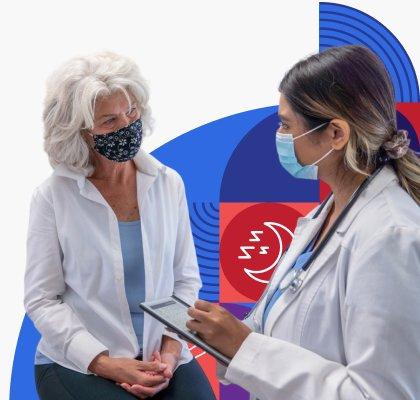Healthy Living
Prevent Infections When You Get Medical Care

The Basics
Overview
You can help protect yourself from infections when you get medical care. This is especially important when you have a medical procedure, like surgery or dialysis.
Take these steps to help prevent infections when you have a medical procedure:
- Talk with your doctor or nurse about infections
- Make sure your doctors, nurses, and visitors always wash their hands before visiting and caring for you — and wash your own hands often, too
- Follow the instructions your doctor gives you for preventing infections after your procedure
How do medical procedures put people at risk for infections?
Germs can spread from one patient to another or from doctors and nurses to patients. You're at higher risk of getting infections from germs if:
- You have surgery or you get an IV (intravenous) tube, a catheter (tube in your vein or bladder), or a ventilator (breathing tube)
- You are very sick
- Your doctors, nurses, and visitors don't take steps to prevent infections, like washing their hands
- You take antibiotics you don't need
The good news is that patients and doctors can work together to prevent the spread of germs and avoid infections. Learn more about preventing infections.
Types of Infections
What types of infections can people get from medical procedures?
Infections people get from visiting a hospital, health clinic, doctor’s office, or other health care facility are called health care-associated infections (HAIs).
These infections can lead to sickness and even death. Examples of HAIs include blood infections and urinary tract infections from catheters.
Learn more about common HAIs:
Signs of Infection
How will I know if I have an infection?
Common signs that you may have an infection include:
- Fever
- Burning or pain below the stomach (the lower abdomen)
- Burning or pain when peeing (urinating) or having to pee more often than usual
- Redness or pain around a catheter or wound
- Pus or other liquid coming from the skin
- Diarrhea (frequent, watery poop)
- Pain that you weren't having before
Take Action
Talk with the Doctor
You and your doctor or nurse can work together to prevent infections by following these steps.
Talk with your doctor about preventing infections.
Before having surgery or getting another type of medical procedure, talk with your doctor or nurse about:
- Any medical problems you have (like diabetes) since some medical problems can raise your risk of getting an infection
- What your health care team will do before the procedure to help prevent an infection, like cleaning the skin with soap
- What you can do to help protect yourself from an infection before and after the procedure
Start the conversation by saying, “I know how easy it is for people to get infections. I don’t want it to happen to me.”
Speak up if something doesn’t seem right.
Don’t be afraid to speak up and ask questions before or after your procedure. For example, tell the doctor or nurse if your bandages aren’t clean, dry, or attached well. Your safety is their priority.
After your procedure, pay close attention to changes in your health. If you get home and start to feel sick or notice signs of an infection, call your doctor or nurse right away.
Hand Washing
Always make sure your doctors and nurses wash their hands.
Ask your doctors and nurses if they washed their hands. This is one of the most important ways to prevent infections. Even if they wear gloves, they still need to wash their hands before putting them on — just wearing gloves is not enough to prevent infections.
You might feel uncomfortable asking the doctors or nurses if their hands are clean — but remember that it’s their job to help keep you safe and healthy.
For more information, check out this patient’s guide to hand hygiene [PDF - 1.4 MB].
Ask your visitors to wash their hands, too.
Make sure your family members and friends wash their hands when they visit you. And if a loved one isn’t feeling well, ask them to call instead of visiting in person.
Follow Instructions
Take steps to prevent infections after a procedure.
It's important to follow all the instructions you get for what to do after a medical procedure. For example, be sure to:
- Wash your hands with soap and water often — especially after using the bathroom, before eating, and before and after touching a wound or catheter
- Ask every day if it's time for the catheter to be removed (if you have a catheter)
- Keep any follow-up appointments
Use medicines safely.
You may need to take antibiotics or other medicines after a procedure. Be sure to follow the instructions on when, how often, and how long you need to take your medicines.
If you're taking antibiotics:
- Take all doses of the antibiotic unless your doctor tells you to stop
- Never share antibiotics with other people
- Safely get rid of any antibiotics that you don't use
- Tell your doctor or nurse if you start having diarrhea
Call your doctor, nurse, or pharmacist right away if you have any questions about your medicine — or if you're worried that your medicine is making you feel worse.
Healthy Habits
Stay up to date on your vaccines (shots).
Ask your doctor about important vaccines to protect you from infections. Learn which vaccines adults need to stay safe.
Quit smoking.
Quit smoking. Patients who smoke get more infections. Talk to your doctor about how you can quit before your surgery. If you smoke, call 1-800-QUIT-NOW (1-800-784-8669) to make your quit plan.
Content last updated August 20, 2024
Reviewer Information
This information on health care-associated infections was adapted from materials from the Centers for Disease Control and Prevention and the Agency for Healthcare Research and Quality.
Reviewed by:
Sheena Harris, MD, MPH
Medical Officer, U.S. Preventive Services Task Force Program
Center for Evidence and Practice Improvement (CEPI)
Agency for Healthcare Research and Quality (AHRQ)


